SR #0: Intro — What's so Special?
 Speaking of sunlight…
Speaking of sunlight…Okay, if you'll all take your seats and quiet down we can begin. I'll keep this very short today because I know it's Spring and many of you are eager to get out there and walk Frisbees and throw dogs… I mean — well you know what I mean.
The point is, that in keeping with spring, I'm aiming to keep these posts light and breezy. Unfortunately, I have terrible aim, so we'll see how that goes. I never met a paragraph I couldn't make longer!
Ready? Let's go…
Today begins a series of posts discussing Special Relativity. I'm going to start off by explaining what makes it "special" as well as what we mean by "relativity." (And note that, from now on, I'll usually just write "SR" — "Special Relativity" is a lot to type!) I'll also introduce you to a few other important basic concepts.
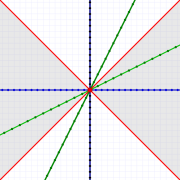 By the time we finish this series of articles, this diagram should make complete sense to you!
By the time we finish this series of articles, this diagram should make complete sense to you!Last Saturday I gave you an overview of some of the consequences of SR. By the end of the series, I hope to have given you a good explanation of how those things occur. It will take us a while to get there, but every journey starts with a single step, so let's take those first steps now.
Basically, this is about motion and, in particular, about relative motion. That's the "relativity" part of the name right there.
If Al is "standing still" and Em is "moving past" then Al sees Em moving relative to himself. But how can we be sure Al actually is the still one while Em is the moving one?
If Al is right next to us — say we're sitting on a bench — we can obviously tell he's not moving closer or further away from us or the bench. We can prove this by reaching out and putting a hand on his shoulder at any time to reassure ourselves he hasn't moved.
As we see Em pass by, we observe her distance decrease as she gets closer and then increase as she gets further. If she passes us closely enough, we might be able to "high-five" as she passes. So, clearly she's moving.
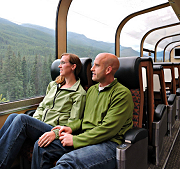 The world passing by!
The world passing by!But what if that bench we're sitting on with Al is in a train car and Em is standing on the platform. We see her (and the platform) get closer, we high-five as we pass, and then she and the platform recede behind us.
Meanwhile, Em sees that she's standing still (relative to the station platform), and from her perspective we and Al have zipped past in the train car.
Both versions (with certain caveats) are correct versions of the event!
The important point here is that Al sees Em as moving relative to him, and Em sees Al moving relative to her. That's exactly what we mean by "relativity."
A key caveat here — the key caveat for the moment — is that the motion must be constant. It cannot involve any slowing down or speeding up. That is what makes the kind of motion we're discussing here "special" (more about that next time).
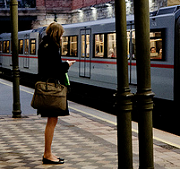 The train passing by!
The train passing by!So long as the train is moving at constant speed — and in a straight line — it is just as correct to say Em is moving as it is to say Al is moving.
The only thing we can say about not moving is that Al is not moving relative to the train car, and Em is not moving relative to the train platform.
You may think Em has the advantage since the train platform is on the ground, which is connected to the whole Earth, so it seems silly to say that Em is moving and Al is not…
But from Al's point of view this is exactly the case! We're sitting next to Al, and we can see he isn't moving. Neither is the bench inside the train car. Everything inside the car is just sitting there (while Em equally obviously is moving past us).
In fact — and this is a really important point — there is no experiment we can perform that proves otherwise. Within the train car, it is absolutely true that we are not in motion relative to the train car. If you've ever been riding in a car and felt like the world was zipping past, that is a completely valid way to view it.
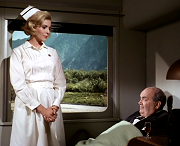 The 'F' train — as in Fake!
The 'F' train — as in Fake!A minor caveat is that the sound and vibration of the train running along the tracks provides a clue that we're moving.
But if you watched the old Mission: Impossible TV show, you may have seen that episode where they trick their target into believing he's on a moving train using sound and mechanical effects.
For that matter, some amusement park rides do a pretty good job of tricking you into thinking that you're moving using the same kinds of effects.
Conversely, if the train car is sound proof and has a smooth suspension, you may feel no sense of motion. Consider what it feels like to ride on a commercial aircraft. You can walk down the aisle with no sense that you're really hurtling through the air at hundreds of miles per hour!
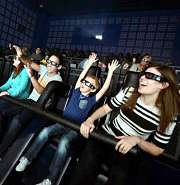 Not actually moving (much).
Not actually moving (much).An important term here is frame of reference. It's a technical term for "point of view" but it includes the idea that — for example — you, Al, the bench you're sitting on, and the entire train car, are part of one thing: a frame of reference.
Em also has a frame of reference: the platform and the train station and — in her case — the entire Earth.
But having that larger frame of reference — even one as big as the Earth — doesn't make hers "better" or preferred. It only means there are a lot more people who share her view that Al and the train are moving.
That's all I want to cover for today. Let's review:
- Special Relativity is about motion of one observer relative to another.
- It's special because that motion must be constant; no slowing down or speeding up.
- In this situation, both observers can make equally valid claims they are standing still while the other is moving.
- Both can also make the equally valid claim that they are moving and the other party is standing still.
- Every observer has their own frame of reference.
- There is no preferred frame of reference; all are equal.
Now go out and play!
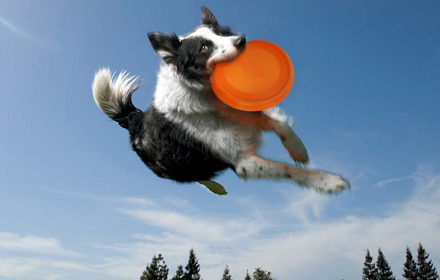 Just keep in mind that some dogs have injured themselves doing this!
Just keep in mind that some dogs have injured themselves doing this!